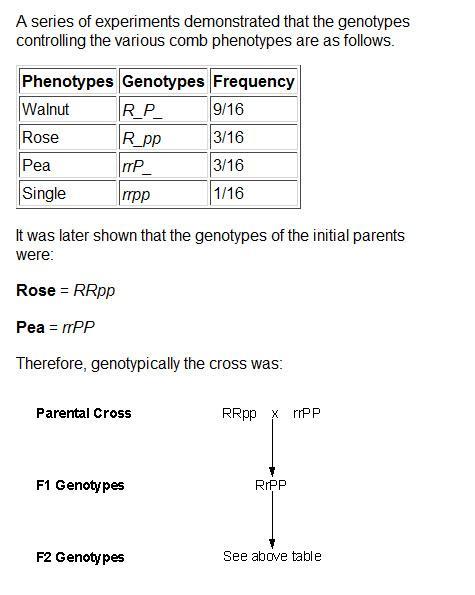Pea comb is incompletely dominant over single comb. Heterozygous birds (Pp) will have an intermediate comb, a single comb with three rows of spikes on the top. Birds with smaller single combs crossed with pea comb birds will produce a small blade with the three rows of spikes on top. Much more noticeable on the male.
Rose comb is dominant over single comb. single comb (p/p r/r) X rose comb (p/p R/R) = rose comb (R/r) I have a hypothesis that the single comb gene does influence the rose comb to some extent.
Duplex comb is incompletely dominant to single comb. Heterozygous duplex/single combed birds produce a single comb that is split in the back with a circle of spikes. Much more noticeable on the male.
There are modifiers that can effect the rose, pea and single combs. This is why you get variations in the combs of birds. Especially when the birds are walnut combed (P/P R/R).
The walnut comb is produced because P is incompletely dominant to R or R is incompletely dominant to P ; either way they both influence each other and you get a walnut comb. With some modifiers you get a cushion comb or a strawberry comb and the other variations of the comb.
Tim
Rose comb is dominant over single comb. single comb (p/p r/r) X rose comb (p/p R/R) = rose comb (R/r) I have a hypothesis that the single comb gene does influence the rose comb to some extent.
Duplex comb is incompletely dominant to single comb. Heterozygous duplex/single combed birds produce a single comb that is split in the back with a circle of spikes. Much more noticeable on the male.
There are modifiers that can effect the rose, pea and single combs. This is why you get variations in the combs of birds. Especially when the birds are walnut combed (P/P R/R).
The walnut comb is produced because P is incompletely dominant to R or R is incompletely dominant to P ; either way they both influence each other and you get a walnut comb. With some modifiers you get a cushion comb or a strawberry comb and the other variations of the comb.
Tim
Last edited:




